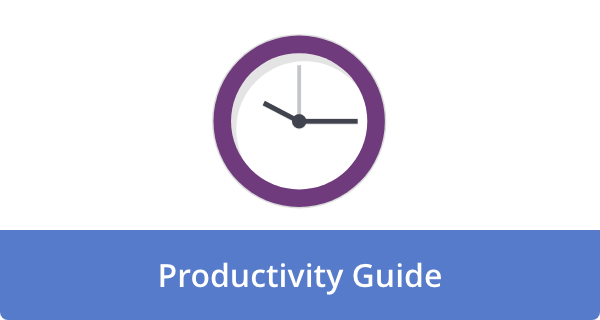

Do you constantly feel pressed for time? If so, your schedule may not be the problem. Perhaps it has to do with your habits.
The good news? It only takes a few minor changes to achieve significant results. Listed below are 17 time-saving habits high performers use to reclaim 10+ hours per week. Adopting even a few will make you feel less rushed and more in control.
1. Decide on your daily “Top 3” priorities.
Often, the start of the day feels like a crossroads where you have many choices to consider. As a result, without a clear direction, you can easily get sucked into urgent tasks rather than vital ones. With a daily “Top 3” priority list, however, you can focus your energy on the activities that matter most to you.
Remember, in the words of Lemony Snicket, “Morning is an important time of day, because how you spend your morning can often tell you what kind of day you are going to have.”
- Time saved weekly: 1-2 hours
- Why it works: By constantly evaluating and choosing tasks, you significantly reduce decision fatigue, a mental exhaustion that results from constant evaluation and decision-making. With it, you won’t have to juggle a sprawling to-do list, providing a laser-like focus on the essential things.
2. Set a timer for deep work (Pomodoro Technique).
The Pomodoro Technique requires you to focus on a single task for 25–30 minutes, blocking out all interruptions from external or internal sources. After the timer rings, take a short 5-minute break to refresh your mind.
With this method, you train your brain to maintain attention, building mental stamina and resilience against distractions. As a result, anticipation of the upcoming break can boost motivation and reduce the difficulty of sustained focus.
- Time saved weekly: 1-3 hours
- Why it works: Whenever we switch our attention from one task to another, our brain requires time and energy to reengage with the original one. The Pomodoro Technique minimizes these hidden time drains, allowing for more efficient and productive work sessions.
3. Prepare a default weekly menu.
“What’s for dinner?” can often drain a lot of energy and time. All this mental deliberation, all the last-minute recipe searches, and the potential for impulsive takeout orders account for a cumulative loss of valuable time. You turn this daily dilemma into a streamlined routine by establishing a default weekly menu.
Instead of asking “What’s for dinner?” daily, select five to seven meals you enjoy and that fit your dietary needs. You can establish a predictable and manageable culinary schedule by rotating these meals throughout the week. Using this menu, create a reusable grocery list template, ensuring you have all the ingredients on hand.
Taking a proactive approach to meal planning reduces stress and time burden, and it also reduces the likelihood of making unhealthy takeout choices.
- Time saved weekly: 2-3 hours
- Why it works: When you pre-plan your meals, you significantly reduce food-related decision fatigue. Also, it prevents you from making impulse purchases at the grocery store, saving you time and money, and preventing the last-minute scramble for dinner ideas.
4. Take advantage of voice notes and dictation apps.
Almost all smartphones and note-taking applications support voice dictation (such as Google Keep or Apple Notes). As such, your phone can record your thoughts, ideas, or reminders by simply speaking them. Doing so lets you capture information instantly without interrupting your current activity. At a later date, you can transcribe and organize these voice notes.
- Time saved weekly: 30-60 minutes
- Why it works: By eliminating the cognitive load of remembering ideas and tasks, forgotten thoughts are prevented from becoming frustrating and time-consuming to reconstruct. In various situations, it enables seamless information capture.
5. Set up automatic bill payments and savings transfers.
Although financial management is crucial, it often involves repetitive and time-consuming tasks such as paying bills and transferring funds to savings accounts. Unless these tasks are automated, we can easily overlook them, resulting in late fees, lost savings opportunities, and unnecessary stress.
Fortunately, most banks and service providers offer direct debit options for your bank account or credit card. Similarly, you can transfer money into your savings account regularly. By configuring these processes, you can forget due dates and automate transactions, removing the psychological burden of manually executing transactions.
- Time saved weekly: 30 minutes
- Why it works: This habit frees up significant mental bandwidth by eliminating the need to manually process payments and transfers. Furthermore, it prevents missed deadlines and promotes consistent saving habits.
6. Unsubscribe from unwanted emails.
According to OnePoll and Slack research, employees still spend more than one working day per week writing emails. “When we look at the data, we’re seeing that employees are spending almost 11 hours a week writing emails, many of which aren’t even getting read—and when they are, they’re often skimmed too quickly and misunderstood,” says Ali Rayl, Slack’s SVP of product management.
You can counteract this by unsubscribing from email lists you are no longer interested in regularly. To streamline this process, you can use tools like Unroll.Me, Gmail filters, or the unsubscribe links at the bottom of emails. Decluttering your inbox by removing irrelevant emails makes it easier to identify and respond to important messages.
- Time saved weekly: 30-60 minutes
- Why it works: Fewer distractions translate into less time sifting through irrelevant information, and less feeling of overload when managing your email communications.
7. Batch similar tasks together.
While multitasking is often lauded as a sign of productivity, it actually drains our cognitive resources and time. By constantly switching between different types of tasks, our brain is constantly re-engaged and re-oriented, decreasing efficiency and increasing error rates..
Instead, set aside specific times for similar activities — aka batching. You can, for example, answer every email you receive once or twice a day rather than every one as it arrives. Instead of making multiple individual trips, group all your errands into one trip. You should also schedule all of your phone calls back-to-back.
Overall, maintaining a single “mode” for a defined period of time optimizes your focus and reduces the wasted time and energy associated with constantly switching gears.
- Time saved weekly: 1-2 hours
- Why it works: Context switching is a hidden time thief. When similar tasks are batch-processed, you minimize mental overhead, allowing you to focus more deeply on each activity.
8. Prepare your clothes for tomorrow the night before.
By laying out your clothes the night before, you can easily create a smoother and more efficient day the next day. Why? In less than a minute, you can eliminate morning indecision by choosing an outfit ahead of time. With a ready-to-wear outfit, you can streamline your routine, freeing up more time for more important tasks..
Overall, this small act of pre-planning can also help you begin your day in a calmer and more organized state.
- Time saved weekly: 15-30 minutes
- Why it works: When you have a smooth morning routine, you reduce stress, save time on decision-making, and begin your day with a positive attitude.
9. Say “No” without overexplaining.
Saying “yes” to everything will inevitably leave you feeling overwhelmed, stretched thin, and resentful. You protect your time and energy by saying “no” politely, directly, and without unnecessary apologies.
You should practice concise and direct refusals. Using phrases such as “Thank you for thinking of me, but I am not available right now” or “I appreciate the invitation, but I am unable to attend” is respectful and clear.
Remember, it’s okay to prioritize your own commitments without providing lengthy explanations. After all, being able to say “no” allows you to protect your time for the things that truly matter.
- Time saved weekly: 1-2 hours
- Why it works: Saying “no” has more than just timesaving benefits; it protects your priorities, prevents burnout, and allows you to focus on commitments that align with your goals.
10. Make a reusable packing list.
Checklists can be developed for your gym bag, your everyday work bag, or your standard travel essentials. These lists can be stored digitally or physically and reused repeatedly. Using this simple system prevents you from forgetting essential items and significantly reduces the mental effort and time spent preparing for these recurring situations.
- Time saved weekly: 30-45 minutes
- Why it works: Reusable packing lists reduce cognitive load when remembering what to pack, prevent last-minute stress when forgotten items appear, and streamline the preparation process.
11. Schedule “Do Not Disturb” blocks.
In our always-on digital world, notifications and interruptions constantly interrupt our concentration, hindering deep, focused work. However, if you use your devices’ “Do Not Disturb” feature, you can create uninterrupted periods of time for concentrating on your tasks.
Schedule specific blocks of time every day when your phone, computer, and other devices will be in “Do Not Disturb” mode. Share your calendar with colleagues and family members to inform them of your inability during these times. Without the constant barrage of digital distractions, you can focus fully on complex tasks in a protected sanctuary.
- Time saved weekly: 1-3 hours
- Why it works: By actively blocking out distractions, you can maximize your productivity hours, reduce reactive behavior, and enable deeper concentration and more efficient completion of complex tasks.
12. Create email templates for common responses.
Identify the email types you send frequently that require similar responses. Next, create templates for these scenarios, including placeholders for personalized details. Most email clients like Gmail and Outlook allow users to save and reuse templates. You can create a professional and informative reply without repeating yourself in just a few clicks.
- Time saved weekly: 30-60 minutes
- Why it works: Using email templates eliminates the repetitive task of rewriting the same information, allowing you to respond faster and more efficiently to common inquiries.
13. Set windows for social media.
Every day, people spend about 143 minutes on social media. When you crunch the numbers, that’s close to 2.5 hours a day spent scrolling.
As a result, instead of checking social media mindlessly throughout the day, set aside specific times (and durations) for engagement. Screen time management tools can help you set limits and track your phone screen time usage. When you consciously schedule your social media time, you prevent it from disrupting your productive hours.
- Time saved weekly: 2-4 hours
- Why it works: Using social media is a direct time drain, but it is also a significant distraction that reduces your ability to focus and engage in deep work. It is important to limit your usage of it to protect your time and concentration.
14. Keep an up-to-date grocery list on your phone.
Creating a grocery list involves mentally listing everything you need, which can take time and lead to omissions. Instead, use something like Google Keep, AnyList, or Apple Notes to add things as you run low easily. This keeps your shopping list up to date and saves you the time to make one before every store trip.
- Time saved weekly: 30 minutes
- Why it works: Keeping a running grocery list reduces the mental effort of recalling necessary items and the likelihood of forgetting ingredients, saves time on planning, and avoids return trips to the store.
15. De-clutter your workspace weekly.
If your workspace is cluttered, whether physical or digital, you may have difficulty focusing and finding what you need. By decluttering your workspace each week, you can make it more efficient and organized.
Dedicate 10–15 minutes once a week to tidying your desk, organizing files, and clearing your digital desktop. A clean and organized workspace reduces visual distractions, speeds up your ability to locate items, and fosters a more focused and productive mental state.
- Time saved weekly: 30-60 minutes
- Why it works: Physical clutter contributes to mental clutter, making it difficult to focus and taking up more time searching for misplaced items. When a workspace is clean, though, it promotes efficiency.
16. Apply the “two-minute rule.”
Procrastination is often caused by the perception that a task will take a long time or be difficult. The “Two-Minute Rule” is a simple yet powerful tool to counteract this tendency. Whenever you can complete a task in less than two minutes, do it immediately.
Many small actions fall into this category, such as replying to an email, putting away a misplaced item, deleting an unnecessary file, or forwarding a document. By handling them immediately, you prevent them from accumulating and creating overwhelm. In addition, it encourages a sense of momentum and accomplishment throughout the day.
- Time saved weekly: 1–2 hours
- Why it works: Small, delayed tasks can consume significant time and mental energy. Handling them immediately keeps things moving forward and prevents them from piling up.
17. Create a “Waiting Time” list.
Every day, we experience pockets of “waiting time”—standing in line, being on hold, and waiting for an appointment. Often, these moments seem unproductive and wasteful. Keeping a “waiting time” list can turn these idle periods into productive mini-wins.
It could be as simple as responding to a text message, deleting old emails, practicing a language flashcard, stretching, or mentally planning your week. Consult your list and complete a quick task whenever you have a few spare minutes.
- Time saved weekly: 30-60 minutes
- Why it works: By incorporating this habit, you’ll be able to reclaim valuable minutes throughout your day.
Final Thoughts
To regain lost time, you don’t need a complete overhaul. If you incorporate just a few of these micro-habits into your routine, you can gain back 10 or more hours a week, time you can reinvest in what is truly important to you.
FAQs
Ten hours a week? That sounds like a lot. Is it really achievable with just these “tiny” habits?
Absolutely!
By accumulating and eliminating wasted moments and inefficient processes, you will be able to become more powerful. You might save just a few minutes here and there by implementing each tiny habit. However, these small savings add up over a week when applied consistently. Consider it as interest accruing on an investment – small contributions add up over time to create a substantial amount. These micro-optimizations can save hours by tackling time-intensive activities like endless email checking, indecision, and reactive behavior.
These habits seem very basic. Am I really not doing some of these already?
You may already be implementing some of these intuitively, which is excellent. However, the key difference lies in consistently and intentionally applying all (or a significant number) of these habits.
Setting a priority list every morning before diving into other tasks creates a powerful framework for your day. Likewise, you might sometimes batch errands, but consciously scheduling specific time blocks is an effective way to improve focus and reduce cognitive switching costs. This guide encourages a holistic approach by adopting these time-saving strategies systematically and intentionally.
Do I need to implement all 17 habits at once to see results? That feels overwhelming.
Nope. Overhauling your entire routine overnight can lead to burnout and abandonment.
Instead, go with a “Start Small” action plan. To begin, choose three to five habits that resonate with you most or seem easiest to implement. Make these habits automatic before introducing new ones. By integrating changes gradually, you can experience the benefits without becoming overwhelmed.
How long will it take to see a noticeable difference in the amount of free time I have?
Timeframes will vary based on which habits you adopt first and how consistently you follow them. Once you begin managing your day more intentionally, you might notice small pockets of extra time within the first week. You will, however, see a greater cumulative impact as you incorporate more habits into your routine. To truly benefit from 10+ extra hours per week, implement consistently over several weeks.
How can I track my progress and see how much time I’m saving?
Initially, you may simply feel like you have more time and less stress. To get a clearer idea of your progress, you might try tracking your time for a few days before implementing the habits and then again after a few weeks. This will give you an idea of how your time allocation has changed.
Alternatively, reflecting each week on how you spent your time and noticing how you have more time for activities that you previously couldn’t handle may indicate progress.
Image Credit: Yaroslav Shuraev; Pexels











John Hall
John Hall is the co-founder of Calendar a scheduling and time management app. He’s also a keynote speaker that you can book at http://www.johnhallspeaking.com.